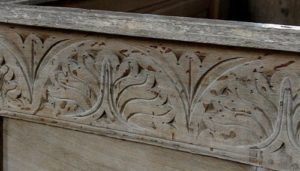Down a short farm lane just off the A361, the church is all that remains of the lost medieval village of Inglesham. Set in the depths of the countryside with only the old rectory and a farm for company, this is a small unchanged church neglected by time.
From the outside it is uninspiring, a box like church covered with plaster render with a small bell cot at the west end and a big porch. Little is known about the history of the church. There seems to have been a Saxon church here and the carving of the Virgin and Child, now at the east end of the south aisle, is Saxon. The present building is probably 13thC and internally has changed little since Cromwell’s time.
The unused north door has huge hinges and is set under a trefoil arch. The south door has the remains of a sanctuary knocker and is studded with nails. Steps lead down into the church.
Inside it is a lovely church, gently mouldering. It is no longer used and maintained by the Churches Conservation Trust. Arcades with round pillars with carved capitals and round arches on the south side and pointed on the north, separate nave from the wide side aisles. The floor is uneven stone slabs. The box pews would have been much taller but have been cut down. A few of original height survive at the back of the north aisle.
To the left of the door is an octagonal font with quatrefoils with flower motifs round the bowl. To the right of the door, a 15th or 16thC parclose screen encloses the south aisle. This has a panelled base with carved ogee arches. Above these is a narrow carved band of flower heads. Above are small tracery arches, still with the remains of red paint. There is another parclose screen between the north aisle and nave.
By the chancel arch is a Jacobean pulpit with carved panels and sounding board above. In front of it is a reader’s desk.
The Lord of the Manor’s pews in the chancel have carved decoration around the top. A similar pattern is also used round the top of the altar table.
There are three blind arches on the north wall of the chancel and a small piscina and aumbry cupboards. Behind the altar is the remains of a 13thC painted reredos with parts of angels. At the base are red and white horizontal stripes. The painting has been overpainted with a later inscription.
Above the chancel arch, at the sides are two flensing angels. In the centre is a later table with the Ten Commandments. The Creed and Lord’s Prayer are painted on the north wall, again over earlier paintings.
The Royal Coat of Arms hangs above the north arcade.
This is a fascinating church with lots of atmosphere. We opened the door and our first words were “This is great”. It is definitely worth finding. The church is open everyday and there is parking at the end of the road. There are steps up into the graveyard and down into the church.










